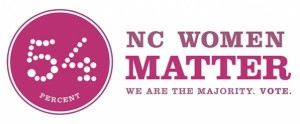The Great Recession and the still-plodding recovery hit women in North Carolina especially hard. Both have compounded the effect of the structural inequalities women have been facing for many years. State policymakers’ decisions to deeply cut the state budget and critical programs for women have worsened the impact of the economic downturn on women.
Women in North Carolina’s labor force are fundamental to families’ economic security and to a thriving economy. Almost 2.3 million women are in North Carolina’s labor force, making up almost half (47.3 percent) of North Carolina’s workers. In North Carolina, 3 out of 4 (77.4 percent) mothers with children under 18 are in the labor force. 42.7 percent of working mothers in North Carolina are the family’s breadwinner.
 Despite the economic recovery, women are suffering continued and worsening economic hardships. Nationally, men lost more than twice the number of jobs that women lost during the official recession from December 2007 to June 2009. However, since the official recovery began, women have lost jobs while men have found them. A recent national survey looking at economic insecurity after the Great Recession found that on almost every measure of insecurity and hardship—including difficulty paying for basics like food, rent or mortgage, and utility bills—the recession inflicted greater hardship on women than on men.In North Carolina, the poverty rate for women increased to 17.7 percent in 2009. Almost 828,000 women in North Carolina, or 1 in 5.6 women, live below the federal poverty line.
Despite the economic recovery, women are suffering continued and worsening economic hardships. Nationally, men lost more than twice the number of jobs that women lost during the official recession from December 2007 to June 2009. However, since the official recovery began, women have lost jobs while men have found them. A recent national survey looking at economic insecurity after the Great Recession found that on almost every measure of insecurity and hardship—including difficulty paying for basics like food, rent or mortgage, and utility bills—the recession inflicted greater hardship on women than on men.In North Carolina, the poverty rate for women increased to 17.7 percent in 2009. Almost 828,000 women in North Carolina, or 1 in 5.6 women, live below the federal poverty line.
State policymakers’ decisions to deeply cut the state budget and critical programs for women have worsened the impact of the economic downturn on women. Women are impacted by the state budget as both recipients of programs and services as well as providers of a variety of state-funded services. With women overrepresented in professions such as teaching, health care, and child care, deep budget cuts to these funding areas hit women harder than men. Women experienced 58 percent of state layoffs in 2011 due to the legislature’s cuts-only approach to the budget. A range of critical programs that benefit women and their children were hit hard by budget cuts in fiscal year 2011-12, including education, early learning programs, and health care.
As a result, it will be more difficult for women to overcome persistent structural inequalities. Women in North Carolina still only earn 80.7 percent of men’s earnings. Women are overrepresented in part-time work, which is more likely to pay lower wages and less likely to offer benefits. In 2010, 28.1 percent of women in North Carolina worked part-time, compared to 17.6 percent of men.
Women’s lives are being directly impacted by decisions made regarding job creation, budget cuts, and education. Our voices must be heard when these decisions are made: vote!
Some key findings from The Status of Women in North Carolina report from the N.C. Council for Women:
- Nearly six in ten women are now in the workforce (U.S. Department of Commerce 2012a), compared to 34 percent of women in 1950 and 43 percent of women in 1970 (Fullerton 1999). Women’s labor force participation in North Carolina reflects this trend; as of 2010, 59 percent of women were active in the workforce.
- In North Carolina, as in the United States as a whole, women have higher levels of education than men. Women in the state are more likely than men to hold an associate’s degree or have some college education (33 percent of women compared to 28 percent of men) or to have a bachelor’s degree or higher (27 percent of women compared to 26 percent of men). A smaller proportion of women than men have not graduated from high school (13 percent of women compared to 17 percent of men).
- Despite women’s higher educational attainment, women’s wages in North Carolina lag behind men’s. In 2010, the median annual earnings for women who work full-time, year-round in North Carolina were $7,000 (or $135 per week) less than the median annual earnings of comparable men; women’s earnings were $33,000, compared to $40,000 for men.
- In North Carolina, as in the United States as a whole, the gender wage gap is even larger when only men and women at the same educational level are compared. Women who have at least a college degree and work full-time, year-round earn more than $20,000 less per year than comparable men (a gender wage gap of 29 percent); for women with some college education or an associate’s degree, the loss of earnings for women is about $10,000 per year (a gender wage gap of 24 percent).
- In North Carolina, poverty status varies considerably by race and ethnicity. Among women in the state, Hispanic women are the most likely to be poor or near poor (64 percent), followed by American Indian (54 percent) and black (52 percent) women. Asian American and white women are the least likely to be poor or near poor (35 percent and 30 percent, respectively).

